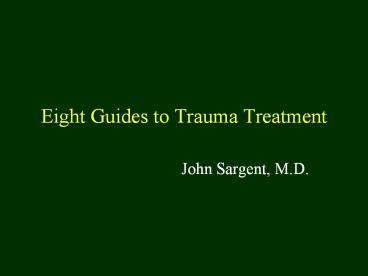Eight Guides to Trauma Treatment PowerPoint PPT Presentation
Title: Eight Guides to Trauma Treatment
1
Eight Guides to Trauma Treatment
- John Sargent, M.D.
2
Learning Objectives
- 1) Learn about the features associated with
traumatic stress in children and adolescents. - 2) Learn an approach to integrating and staging
treatment of traumatic stress in children and
adolescents.
3
- This presenter has no conflicts to declare
4
- The presenter has no conflicts of interest to
declare.
5
Characterizations of Trauma
- Significant Danger
- Unexpected and unpredictable
- Uncontrollable - inducing helplessness
6
- Potentially leading to CNS changes
- Alterations in arousal and shut off
- Alterations in memory formation (disconnected,
highly visual)
7
- Dissociation and numbing are common
- Trauma always includes loss
8
Trauma responses vary
- Based upon previous traumatic experiences or
psychiatric disorder - Based upon temperament, attachment relationships
and potentially upon genetic endowment
9
- Based upon parental experience with PTSD
- Based upon degree of social support and community
attributions about the trauma
10
- Based upon degree of dissociation and the
presence of substance abuse and depression - Based upon experiences with modeled violence
- Based upon degree of personal responsibility,
guilt and shame associated with the trauma
11
Aspects of the traumatic event(s) also influence
trauma responses
- Single vs multiple events
- Impersonal - Natural Disasters
12
- Interpersonal
- Attachment Trauma
13
- Combination - e.g. Accidents, War
- Coupled with subsequent disruptive events
- Loss of important relationship
14
- Loss of community safety
- War
- Torture
- Community Violence
- Refugee Experience
- Domestic Violence
15
- Loss of health
- Invasive medical procedures
16
Key variables
- Predictability
- Control
17
- Meaning and context
- Protection
18
- Stability
- Opportunity to reestablish day-to-day routines
and competency
19
- Continuity and connection
- Forgiveness and reconciliation vs. rage and
retribution - Chronic difference vs. recovery
- Community memorialization
20
Guides to Treatment - Often Intersect and Interact
- Safety
- usually includes heroic and courageous
- actions
21
- Usually connects individuals to agents of
community - police, health care system, legal
system, social service and mental health system
22
- Basic Needs
- food, clothing, shelter
- Often involves charity, victim status, unequal
hierarchy and acceptance of need and need for help
23
- Knowledge
- not only information but a relationship within
which necessary information is asked for and
provided
24
- Behavioral Routines
- oriented toward recovery - build competency and
reorient victims toward life after trauma
25
- Emotional Expression, Labeling and Support
- identifying separate important affects and
renders them comprehensible and allows expression
and modulation within attachment relationships
26
- Embedding Support within a Network of Support
- rebuilds a community responding to affect and
united in supporting each other
27
- Narrative Creation
- builds coherence, context and a sense of
groundedness. The trauma victim is the author.
The story distances the author from the story and
displaces dissociation with understanding and
continuity, role of psychotherapy
28
- Justice
- opportunities for accountability acceptance of
blame, apology, forgiveness, and reconciliation
29
- Examples
- Survivor mission, altruism, truth and
reconciliation experiences. Reparations and
advocacy for human rights and community efforts
toward integrity and a just society,
memorialization and artistic expressions,
journals and recollections

